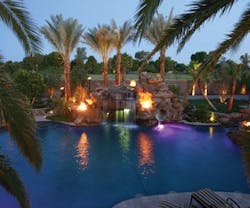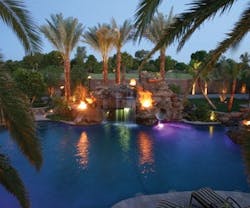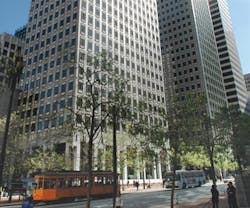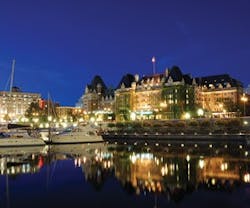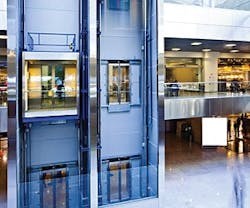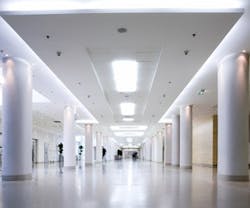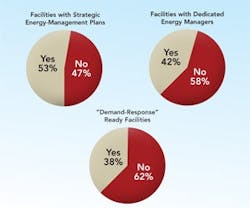Newsworthy
Make Your Pool Green (in a Good Way)
Swimming pools can be a big energy drain. Pentair Water Pool and Spa’s Energy Initiatives Program Manager Jeff Farlow discusses ways to make your building’s swimming pool more energy efficient.
COURTESY OF PENTAIR WATER POOL AND SPA
BUILDINGS: What are the least energy-efficient components of swimming pools?
Farlow: The least energy-efficient component of a swimming pool is almost always the circulation pump. That’s the heart of the equipment room and is generally one of the highest electrical uses in a facility. Standard pump motors offer opportunities for efficiency gains, as there are new model pumps that are much more efficient. You’ve heard a lot about variable frequency drives in HVAC/R systems; the same concept applies in pool filtration. The slowest possible speed is the most efficient, and conventional pumps operate at only one speed – the top speed. Upgrading to a pump with variable speed capabilities can dramatically reduce energy costs. A number of communities with high pool populations, including Florida and California, have passed laws banning single-speed pumps.
Another aspect to consider: If pools and aquatic facilities aren’t properly maintained, the equipment could suffer and be forced to perform under adverse circumstances that can lead to increased energy costs and longer turnover times, and can shorten equipment life.
BUILDINGS: What can facilities managers do to make swimming pools more energy efficient?
Farlow: Facility managers should be looking at variable-speed technology or minimum premium efficiency motors. Properties with moderate-sized pools using a 3-horsepower or smaller pump can achieve the energy savings of variable-speed pump technology by installing pumps that have been proven to lower energy requirements. For larger pools, commercial-scale variable frequency drive systems are available. The level of savings will vary by pool design; in general, slowing motor speed by 10 percent can produce energy savings of nearly 25 percent. In some cases, a smaller variable-speed pump can replace a larger single-speed pump to further reduce energy use.
LED pool lights and high-efficiency heaters and heat pumps also offer the potential for energy savings. We know of facilities that are saving close to $10,000 per year by using variable-speed pumps and other energy-efficient products. That’s a tremendous opportunity to put money back into the facility.
BUILDINGS: What can facilities managers do to reduce maintenance and operating costs?
Farlow: Start by examining pool equipment for opportunities to increase energy efficiency. If you’re contracting with a pool professional or service company to maintain the pool or inspect equipment, make a point of letting them know that energy efficiency is important. Following a strict maintenance schedule will help avoid unnecessary maintenance/replacement expenses and aid equipment efficiency.
The programming capabilities of the more energy-efficient equipment may deliver operational improvements if a pool doesn’t currently have automation equipment.
An investment in salt-chlorine sanitization can also make a pool easier to maintain and lower operating costs. These systems remove the need to purchase, store, and transport chemical chlorine, instead using ordinary table salt to produce pure chlorine. These systems won’t normally have an impact on energy efficiency.
Just like appliances, buildings will soon have energy ratings and be required to disclose energy performance.
“Energy ratings systems, such as ENERGY STAR, are an effective way to easily communicate to consumers the cost to run an appliance. With buildings, we should have a similarly easy way to communicate energy use,” says Susan Coakley, executive director of Northeast Energy Efficiency Partnerships (NEEP).
Valuing Building Energy Efficiency through Disclosure and Upgrade Policies: A Roadmap for the Northeast U.S., a NEEP report, suggests that policies disclosing a building’s energy use can be effective in getting markets to value energy efficiency, create jobs, and reduce greenhouse-gas emissions.
Energy performance disclosures give consumers the tools to make informed choices and protect themselves against poor buildings and building components, higher-than-anticipated energy bills, discomfort, or unplanned renovation needs, Coakley says. Building energy ratings also provide a market-based mechanism for creating a common currency regarding building energy use.
Retrofitting existing buildings has the potential to generate as much as 17 percent in energy savings, which is why NEEP is calling on states in the Northeast to adopt mandatory building energy rating systems.
NEEP’s report provides a guide for Northeast states that are considering the adoption of building energy rating policies. The guide helps ensure that the policies add real value to consumers, achieve cost-effective energy savings, and avoid needless costs and disruptions.
“This report marks a first step toward introducing building energy ratings as a much-needed public policy for Northeast states,” says Jim O’Reilly, NEEP’s public policy director.
A national campaign is recognizing 10 states and localities that demonstrate a commitment to promoting energy-efficient buildings. Launched by the Building Codes Assistant Project (BCAP), Ten Places to Watch in 2010 exists to facilitate sharing of experiences, best practices, and resources.
Cities and states can demonstrate their commitment to energy-efficient buildings and gain recognition from BCAP by adopting the recent versions of the International Energy Conservation Code (IECC) and ASHRAE Standard 90.1, delivering compliance training, running enforcement programs, or promoting above-code innovation.
So far, nine of the 10 locations have been selected:
- Austin, TX
- Georgia
- Idaho
- Kansas
- Massachusetts
- New Hampshire
- New York City
- Rifle, CO
- Santa Fe, NM
“The campaign will educate state and local officials on how to improve building efficiency through codes. It will not only foster information exchange, but also raise awareness on the fundamental role of building energy codes,” says Robin Snyder, BCAP program director.
Follow along and learn from the experience each locality is sharing by visiting www.bcap-ocean.org/tenplaces.
First Class of Green Purchasing Accredited Professionals
The first class of Green Purchasing Accredited Professionals (GPAPs) recently “graduated” – there are now 20 professionals in the commercial buildings field who can add the new GPAP credential to their business cards, showing their clients and tenants that they have acquired knowledge of best practices in green product evaluation and procurement.
The first class of GPAPs includes property managers, sourcing specialists, and designers. The members of the class completed online courses and an exam that was developed by The Green Standard.
Green Purchasing Accredited Professional training encompasses diverse training tools and provides an efficient framework for use of green procurement standards and eco-labels, industry-specific standards and certification programs, and multiple- and single-attribute eco-labels The six modules are supplemented by case studies, and participants are required to pass a comprehensive, 56-question exam in order to be accredited and use the GPAP designation.
San Francisco Building First in Area to Attain BOMA 360 Status
Market Center in San Francisco’s Financial District is the first in the Bay Area to attain BOMA 360 status.
What does this mean for the building? The BOMA 360 Performance Program validates and recognizes commercial properties that demonstrate best practices in operations and management, and helps distinguish a property in a demanding market. By achieving this status, it demonstrates that Market Center is being managed to the highest standards of excellence by its asset manager (RREEF) and property manager (CB Richard Ellis).
“This program goes beyond simply certifying sustainable practices,” says Lisa Vogel, vice president of RREEF. “The BOMA 360 certification includes a full evaluation of all disciplines involved to provide optimal property management: financial management, leasing practices, community involvement, life and safety, security, tenant relations, and training.”
“BOMA 360 encompasses everything from energy efficiency to tenant care, community involvement, and safety and emergency preparedness, as well as state-of-the-art operations and efficient management practices,” says Marc Intermaggio, executive vice president of BOMA San Francisco.
The program is an online self-assessment that evaluates properties in six areas:
- Building operations and management
- Life safety/security/risk management
- Training and education
- Energy
- Environment/sustainability
- Tenant relations/community involvement
The program takes a holistic approach to evaluating a building’s operations and management, and benchmarks a building’s performance against today’s industry standards. To learn more about the BOMA 360 Performance designation, or find out how you can get involved and get your own building certified, visit www.boma.org/GetInvolved/BOMA360.
Green Economy Booms in British Columbia
The green economy in British Columbia could be worth more than $27 billion by 2020, according to a study by the GLOBE Foundation of Canada. The report evaluates the economic and employment impacts associated with the transformation of the provincial economy toward lower-carbon energy generation and usage, as well as business and building practices that reduce greenhouse-gas emissions.
British Columbia’s Green Economy: Building a Strong Low-Carbon Future stresses that abundant natural resources, clean energy choices, and advanced research and educational strengths position British Columbia to realize significant economic and employment gains from the pursuit of low-carbon business and building opportunities.
The report identifies six sectors that form the core of British Columbia’s green economy:
- Clean and alternative energy
- Energy management and efficiency
- Green building
- Environmental protection
- Carbon finance and investment
- Green knowledge
The report suggests that the number of direct and indirect full-time equivalent jobs in the province will grow to more than 225,000 by 2020, and explains that these job numbers could increase through the greening of traditional careers, increased education and training programs for green trades, and easing labor supply constraints for key occupations (such as engineers through immigration).
Currently, almost 90 percent of green jobs and gross domestic product are generated in the province’s southern development regions. The report cites potential for green job growth in other areas of the province; particularly, opportunities arising from the adoption of renewable energy and green practices.
“There‘s great potential for British Columbia to be at the forefront of the emerging green economy by taking advantage of its existing assets, such as renewable energy resources and a diverse workforce,” says John Wiebe, president and CEO of the GLOBE Foundation. “This report demonstrates a promising future for British Columbia’s low-carbon sectors, even using conservative growth estimates.”
Changes Proposed to Standard 90.1
Why light an elevator if no one’s in it? Inefficiency of ventilation fans and cab lighting in elevators are now being addressed, thanks to proposed addendum df to Standard 90.1, Energy Standard for Buildings Except Low-Rise Residential Buildings.
Proposed addendum df would require elevator cab lighting systems to have efficacy of not less than 35 lumens per watt. It would also require cab ventilation fans for elevators without air conditioning to not consume more than 0.7 W*s/L at maximum speed; when stopped and unoccupied, with the door closed for more than 15 minutes, cab interior lighting and ventilation would be de-energized until required again for operation.
Also open for public review is proposed addendum di, which sets requirements for parking garage ventilation. In 1999, the standard required garage ventilation fan systems with total design capacity of more than 30,000 cfm to have either an automatic control capable of staging fans or modeling fan volume, or an automatic control capable of shutting off fans or reducing fan volume when the garage was not in use. ASHRAE’s HVAC Applications handbook recommends: “If permitted by local codes, the ventilation airflow rate should be varied to conserve energy.”
Following is a partial list of the proposed addenda:
- 90.1 ck would allow for more flexibility in meeting ventilation requirements.
- 90.1 dh would clarify the credit for onsite renewable energy and site-recovered energy.
- 90.1 dk would add clarity and instruction about the envelope tradeoff option (new skylighting and daylighting requirements that were added in previous addenda).
- 90.1 do would clearly establish the goals and requirements of lighting systems to ensure that owners are provided all the information necessary to best use and maintain the lighting systems. If no comments are received on these addenda, they will likely be incorporated into the 2010 version of the standard.
Greener Roots Take Hold
More companies are utilizing green techniques, such as designing a building to reduce the amount of water needed for operation or choosing a location so it doesn’t disturb nearby wetlands, soil, or streams. More companies are also installing systems to capture wastewater for future use.
Controls for HVAC, lighting, CO2, and other systems are being managed with total building systems to optimize the comfort and safety of occupants, and to minimize energy, water, and emissions.
“While businesses are still seeking to achieve an acceptable ROI for their green building initiatives, they’re also beginning to show a greater general concern for the environment,” says Bruce Tompkins, executive director of Tompkins Supply Chain Consortium, and author of the Facility Sustainability Survey Report, which indicates an increase in the use of green methods and processes in building design and operation. “Decisions are still being made based on the bottom line, but this general concern shows that companies are increasing their triple bottom line: people, planet, and profit.”
Investment Potential Rises as Property Values Sink?
Nearly 75 percent of executives surveyed recently by Deloitte expect interest rates to rise in 2010, with almost 50 percent expecting rates to increase by 50 basis points or more. More than half of the executives think cap rates and discount rates will increase.
“The commercial real estate market continues to be adversely affected by one of the deepest recessions in decades,” says E.J. Huntly, principal at Deloitte Financial Advisory Services LLP. “Increased unemployment has resulted in less demand for office space, reduced rents, and an overall decline in commercial property values. Right now, commercial real estate executives are weighing their options, determining if the time is right to invest while prices remain depressed and before interest rates begin to rise.”
Almost half of executives surveyed were either already investigating potential acquisitions, or expect to do so within the next year.
How Advanced Are Your Energy Management Practices?
Just over half of the 300+ respondents to a recent BUILDINGS survey have a strategic energy management plan in place for their buildings. Of the “yes” responses, 67 percent of healthcare/medical facilities and computer/high-tech buildings have a strategic energy management plan in place, while just 40 percent of retail/chain facilities have a plan in place.
More than half of the readers who responded have an energy management plan in place, but fewer than half have a dedicated energy manager on staff to drive energy management efforts. Of these “yes” responses, almost 73 percent of communication/transportation/utility facilities have a dedicated energy manager, while a mere 20 percent of retail/chain facilities answered the same.
Only 38 percent of respondents said that their building automation systems are “demand-response” ready. Of the “yes” responses, two-thirds of computer/high-tech facilities have building automation systems that are “demand-response” ready, while one-seventh of hospitality facilities do.
